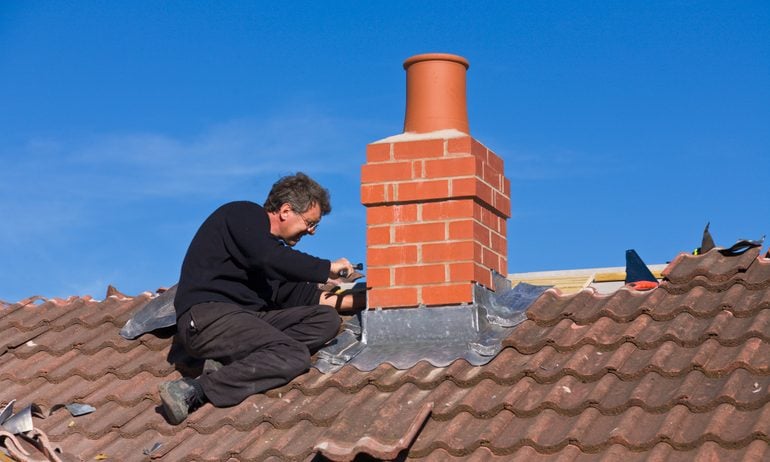How Much Home Insurance Do You Need?
Checking your policy limits on a regular basis can ensure that your coverage doesn’t fall short.

Many, or all, of the products featured on this page are from our advertising partners who compensate us when you take certain actions on our website or click to take an action on their website. However, this does not influence our evaluations. Our opinions are our own. Here is a list of our partners and here's how we make money.
A tornado rips through your town, reducing your home to a pile of rubble. In the aftermath, you discover that it’ll cost $350,000 to rebuild your home, but your homeowners insurance policy offers only $300,000 worth of coverage. That leaves you on the hook for the rest.
To avoid being underinsured for this type of catastrophe, review your home insurance coverage on a regular basis. Here’s how to figure out how much homeowners insurance you need.
All your insurance info, all in one place.
See your policies anytime, anywhere. Plus, get notified when it's time to renew or shop. Just link your insurance to your free NerdWallet account.
Insuring your home
Start by making sure you have enough dwelling coverage, which pays for damage to the structure of your home. This includes the roof, walls and floors, built-in appliances, and attached decks and garages.
If you’ve got a shed, fence or other detached structures, you’ll also want to check your limit for other structures coverage.
Dwelling coverage
You should have enough dwelling coverage to rebuild your house if it’s destroyed. This amount is also known as the “replacement cost.” Note that it may not necessarily be the same as the price you paid for the home or the selling price today.
The replacement cost will reflect the size of the house, its features and the cost of building in your area. For example, a big house with a high-end gourmet kitchen will cost more to rebuild than a modest ranch with standard fixtures. Your insurance company or agent can help you choose an accurate replacement cost.
Note that improvements you make to your home could boost your replacement cost. To make sure your coverage keeps pace, tell your agent about any major renovations you've made.
Learn more about dwelling coverage.
Guarding against rising costs
Your dwelling coverage limit may have been high enough when you and your agent first came up with it. But what if inflation or natural disasters have sent building costs skyrocketing since then?
There are a few ways to make sure your dwelling coverage won’t fall short. First, ask your insurer if there’s an inflation guard on your policy. This will automatically raise your coverage levels on a regular basis to hedge against inflation.
Second, ask whether your insurance company offers either of these options:
Extended replacement cost, which will pay up to a given percentage above your dwelling limit if your coverage isn’t enough.
Guaranteed replacement cost, which will pay as much as necessary to rebuild your home after a covered claim.
These options may cost more than the default coverage, but they could make a big difference in your payout after a claim.
Finally, you may also want to ask about ordinance or law coverage, which pays to bring your home up to current building codes during covered repairs. If you have an older home, making these updates could get expensive if you don’t have ordinance or law coverage.
Other structures coverage
Do you have a shed, fence or detached garage? Make sure you have enough other structures coverage.
Insurers generally set other structures coverage at 10% of your dwelling limit. So if you’ve got $250,000 of dwelling coverage, you’ll have $25,000 for other structures. You may need to raise this amount if it’s not enough — for example, if you have a large studio in your backyard that would be expensive to rebuild. If you don’t have any detached structures, you may be able to remove this coverage altogether.
Learn more about other structures coverage.
Insuring your stuff
Furniture, clothing, electronics and other belongings are covered under the personal property section of your homeowners policy. Your personal property limit should be enough to replace all your belongings if they’re destroyed.
Personal property insurance
Trying to figure out how much all your stuff is worth can be overwhelming. Insurance companies typically set your personal property limit at a fixed percentage of your dwelling coverage limit, such as 50% or 70%. You can usually revise the limit up or down, depending on the value of your stuff.
The best way to estimate how much personal property coverage you need is to make a home inventory. This survey of everything you own can help you determine how much coverage you need and can also be useful when filing a claim.
You can also use this quick personal property calculator to get a rough estimate of how much your stuff is worth.
In addition to choosing the right amount of personal property insurance, it’s also worth asking about how your belongings are covered.
Actual cash value vs. replacement cost coverage
Many standard homeowners policies cover your belongings on an “actual cash value” basis. This means if your stuff is stolen or destroyed, the insurance company will pay you the amount the items were worth at the time of the incident. Because most items lose value over time, you may not receive enough to buy brand-new replacements.
To avoid this, ask about upgrading to replacement cost coverage for your belongings. With this coverage, the insurer will pay enough for you to buy new items of similar quality.
Named perils vs. open perils
Most homeowners policies cover your stuff for damage from causes specifically named in your policy. These causes, known as “perils,” typically include things like fire, theft, vandalism and wind.
You may be able to broaden your personal property coverage to “open perils” or “special perils” coverage. With this option, your insurer will pay for damage from any cause that your policy doesn't specifically exclude.
Learn more about personal property coverage.
Coverage for valuable items
Homeowners insurance policies often have limited coverage for valuable items such as jewelry, furs, electronics and firearms. Jewelry theft may be covered only up to $1,500, for instance.
Depending on your insurer, there may be ways to make sure your valuables are properly covered. Scheduled personal property is one option, in which you insure an individual item such as an engagement ring. Your insurer may require you to submit an appraisal.
An appraisal is an evaluation of how much your stuff is worth, done by a jeweler or other professional.
The other option is blanket coverage for a collection of valuables. This option raises the coverage limit for a given category, such as firearms or electronics.
Protecting your finances
Homeowners insurance doesn’t just cover your house and the stuff inside it. Your policy also covers you if you accidentally hurt someone or damage their property. This coverage comes in two forms: liability and medical payments.
Personal liability coverage
If someone sues you because they slipped on your icy sidewalk or your dog bit their child, personal liability insurance can help. It will pay for your legal defense and cover damages if you’re found at fault, up to your policy limit. It can also cover the payout if someone files a claim against your policy for injuries or property damage for which you’re responsible.
Homeowners liability insurance limits typically start at $100,000, but higher amounts may be a better choice if any of the following risk factors apply:
You have a lot of savings or other assets that someone could target in a lawsuit.
You like skiing, hunting or other activities where you could potentially injure others.
You have a dog, a swimming pool, guns or a trampoline.
You often host parties at your home.
Regardless of your risk, it’s wise to select a liability limit at least high enough to cover your assets.
If you can’t get enough coverage through your homeowners policy, ask your insurer about umbrella insurance. This is a separate policy that extends your liability coverage beyond the amount in your underlying policies.
Learn more about personal liability insurance.
Medical payments coverage
Medical payments coverage is designed to cover small expenses if someone gets injured on your property or due to your actions. For example, it could pay if someone trips on your stairs and needs a few stitches at urgent care. You don’t necessarily need to be found at fault for this coverage to pay.
Limits for this coverage tend to be relatively low, ranging from $1,000 to $5,000. As with liability coverage, you might want to choose an amount on the higher end if you feel you’re more likely to use this coverage (if you have a dog, for example).
Covering your living expenses
The final piece of your homeowners insurance policy is loss of use coverage, also known as additional living expenses. This coverage pays for you to live elsewhere while your home undergoes covered repairs.
For example, it can take many months for your home to be rebuilt after a fire. Loss of use coverage can help cover the cost for you to rent another house during that time.
Many insurers set loss of use coverage at a percentage of dwelling coverage, such as 20% or 30%. Others may specify a length of time for coverage, such as 12 or 24 months.
To determine whether your coverage limit is high enough, look at rental prices in your area. Note that your policy might also need to cover costs such as restaurant meals, additional commuting and moving expenses.
Learn more about loss of use coverage.
All your insurance info, all in one place.
See your policies anytime, anywhere. Plus, get notified when it's time to renew or shop. Just link your insurance to your free NerdWallet account.
Other homeowners coverage you might need
You’ve set all your coverage limits, but you’re not quite done yet. To fill in any remaining coverage gaps, consider whether you need the following additional policies or endorsements:
Water backup coverage. Pays for water damage if your sump pump fails or a drain backs up.
Flood insurance. Pays for damage due to storm surge, heavy downpours or overflowing bodies of water. Most flood insurance is backed by the federal government, though you can buy it through many major insurers.
Earthquake insurance. Pays for earthquake damage, which standard homeowners policies don't cover.


